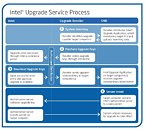- Joined
- Oct 9, 2007
- Messages
- 47,638 (7.44/day)
- Location
- Dublin, Ireland
| System Name | RBMK-1000 |
|---|---|
| Processor | AMD Ryzen 7 5700G |
| Motherboard | Gigabyte B550 AORUS Elite V2 |
| Cooling | DeepCool Gammax L240 V2 |
| Memory | 2x 16GB DDR4-3200 |
| Video Card(s) | Galax RTX 4070 Ti EX |
| Storage | Samsung 990 1TB |
| Display(s) | BenQ 1440p 60 Hz 27-inch |
| Case | Corsair Carbide 100R |
| Audio Device(s) | ASUS SupremeFX S1220A |
| Power Supply | Cooler Master MWE Gold 650W |
| Mouse | ASUS ROG Strix Impact |
| Keyboard | Gamdias Hermes E2 |
| Software | Windows 11 Pro |
The Pentium G6951 dual-core LGA1156 processor may not have made any headlines when it was known to be almost identical to the Pentium G6950, until now. Intel designed the G6951 to support "hardware feature upgrades" by purchasing them and enabling them using a software, so users with this processor installed can upgrade their systems by enabling that are otherwise locked for the SKU. The $50 upgrade fetches support for HyperThreading Technology, enabling four threads on the processor; and unlocks the disabled 1 MB of the L3 cache (Clarkdale has 4 MB of L3 cache, of which 1 MB is disabled on the Pentium SKUs).
There isn't much value in buying a $99 Pentium G6951 and the $50 Upgrade Card upfront, but later down the line, companies can opt to mass-upgrade system performance without touching any of the hardware inside. The service works by the purchase of an upgrade key that the user has to feed into the software, which is then verified by Intel's activation server, following successful verification, the software unlocks the processor's features. This is a one-time process, portable between software reinstallations.

View at TechPowerUp Main Site
There isn't much value in buying a $99 Pentium G6951 and the $50 Upgrade Card upfront, but later down the line, companies can opt to mass-upgrade system performance without touching any of the hardware inside. The service works by the purchase of an upgrade key that the user has to feed into the software, which is then verified by Intel's activation server, following successful verification, the software unlocks the processor's features. This is a one-time process, portable between software reinstallations.

View at TechPowerUp Main Site

 Would be no need to release those "K" processors, enthusiasts would just do this for their current CPU.
Would be no need to release those "K" processors, enthusiasts would just do this for their current CPU.




